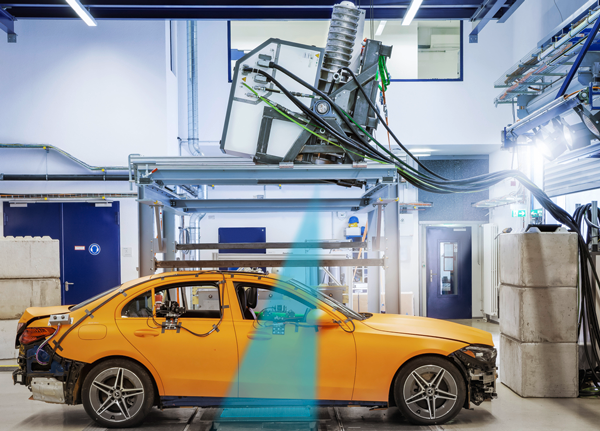
Mercedes-Benz has conducted a crash test using x-rays, enabling the company to record information of the effects of the impact on the vehicle, its components, its structure and on a test dummy at the moment of, and during, the crash test.
Using a C-Class saloon, Mercedes, with its partners the Ernst Mach Institute (EMI) and the Fraunhofer-Institute for High-Speed Dynamics, performed a side-impact test at 60km/h.
A linear accelerator, suspended above the impact spot, served as an X-ray camera. Mercedes says the device is powerful enough to allow all materials commonly used in vehicle construction to be screened and makes it possible to record deformation processes in the crash test without motion blur.
The linear accelerator generates a stream of X-ray pulses. During the crash test the beams shine through the bodywork and any dummies, and a flat detector, located under the test vehicle, serves as a digital image receiver. When the radiation hits the detector, an electrical signal is generated. The intensity of this depends on how strongly the radiation was previously absorbed by the vehicle and dummy structure. This influences the grey value that is later visible – similar to the X-ray inspection of luggage at the airport or images of this kind taken by a doctor.
In the milliseconds of the actual impact time, the X-ray system shoots around 100 still images. Combined into a video, they provide insights into what happens inside safety-relevant components and in the dummy’s body during a crash.
The company added that the X-ray system does not affect any other analysis tools. Even the interior cameras in the crash test vehicle record without any disturbance.
“This technology demonstration (proof of concept) at the EMI research crash facility in Freiburg has shown that high-speed X-ray technology can be used to visualise highly dynamic internal deformation processes,” the company said. “Previously invisible deformations and their exact processes thus become transparent. The numerous, high-resolution images allow precise analysis.”
Source: Motor Trader e-Magazine (April 2024)
23 April 2024
